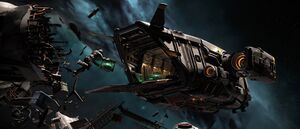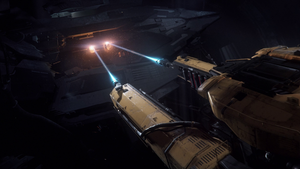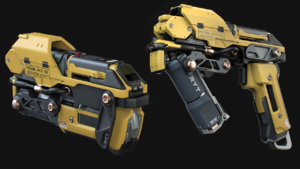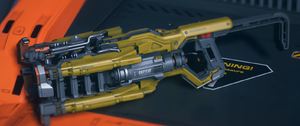Choosing a ship and equipment

Currently, two in-game ships are suitable for salvaging operations:
- Drake Vulture: recommended for solo or small crew operations.
- Aegis Reclaimer: recommended for large-scale reclamation projects with multiple crewmembers.
Salvaging by hand (also referred to as FPS salvaging) requires a multitool with the Cambio-Lite SRT Attachment or the dedicated Cambio SRT, as well as the associated canisters for each.
Salvaged materials will need to be stacked in a ship's cargo hold with a tractor beam. You may choose either a multi-tool and its tractor beam attachment, or you can use the dedicated MaxLift tractor beam.
Types of salvaging operations

- Recovering ship components, weapons, and cargo
- Hull scraping, in which the ship's outer material is removed and converted into recycled material composite
- Structural salvaging, which involves disintegrating the ship and turning the fragments into construction materials
Finding salvage
Shipwrecks can be stumbled upon during your travels in the verse, or you can use your ship's scanner (default keybind: V) to send out a radar ping (default keybind: Tab ↹) and actively search for wrecks. Alternatively, you may peruse your mobiGlas contracts app for salvaging missions. This usually involves a buy-in fee to acquire a wreck's position, although certain illegal salvage jobs may offer this location for free.
Hull scraping guide
With a ship

Approach the shipwreck with your salvage ship until within range of your salvage laser's reach. Switch your ship to salvage mode (default keybind: M), and aim your laser at the wreck. The interface will reflect the suitability and material availability for hull scraping. Blue-outlined fuselage sections indicate excellent amounts of salvageable material, yellow-outlined sections indicate mediocre amounts, and red-outlined sections indicate useless or nearly-depleted amounts.
Depending on your salvage goals you can choose from different scraper modules, such as Abrade or Cinch on the Drake Vulture. Choose which laser module you would like to use by clicking the Right Mouse Button. To begin scraping the hull, click the Left Mouse Button. The salvage lasers will activate and start removing hull material.
The lasers are mounted on gimballed slots, and you can use the default keybind G to enable gimbal mode.
As you acquire material, your ship's interface will indicate when it has filled up a cargo container. Further hull scraping is not possible until the container is ejected by the on-board filling station. If the filling station's storage area is already occupied by another container, you will not be able to continue salvaging until that container is removed. To do so, use a Pyro RYT Multi-Tool with a TruHold Tractor Beam Attachment and move the container to your ship's cargo grid. Then use the filling station's screen to eject the container inside. You may want to bring along a friend or hire a crewmember to oversee this task.


By hand
Ensure you have equipped yourself with either:
- a Pyro RYT Multitool with a Cambio-Lite SRT Attachment, and at least one canister, or
- a Cambio SRT, and at least one of its canisters.
Approach the wreck and aim your tool at the hull. Your interface will use the same colors (blue, yellow, red) as the shipboard UI to indicate the amount of available hull material. Click the Left Mouse Button to activate the tool's laser beam and begin collecting material. Switch out canisters as necessary when they fill up.
Hull patching
RMC collected in a canister can be used to patch the hull of a ship. Aim your tool at the hull and switch it over to patching mode (default keybind: B). Aim at a section of hull which has been damaged, then click the Left Mouse Button to activate the laser. The tool will begin extracting material from the canister and patch up your ship's damaged hull.

Selling acquired materials
Various locations around the verse are seeking to buy your reclaimed goods:
- Ship components and weapons will be sought after by shops such as Platinum Bay, Dumper's Depot, or Cousin Crow's.
- Cargo is usually in demand at major landing zones and outposts, depending on their specialization. Consult a local trade kiosk to find out.
- Recycled material composite can be sold at Trade & Development Division offices or scrapyards.
- Construction materials are in demand at admin offices.